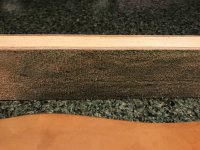In no way is this meant to be a definitive process for making a razor shave ready on your own, but an attempt to explain what I have done 5 times to produce a comfortable and effective shave on a variety of styles and razor conditions that superbly compare to those shave ready razors I have received from online vendors.
You will see all my shave ready equipment. I keep it all in a plastic case which includes wet/dry sand up to 2500, 0000 steel wool , Mothers metal polish. This case includes micro fiber cloths, pastes, and tools.
You will notice I use a 12x12 white marble tile and a full sheet of lapping film. This is not necessary, but it is what works for me. You can cut the lapping film into strips and use a more narrow tile.
You need to spray water on the tile once it has been cleaned. You then take the credit card and squeegee so no water is underneath the film. You then spray water on the film. You simply move forward and back keeping the blade and not the shoulder on the film/tile for 30-40 laps before moving to the next lower numbered grit. Take your time, so slow, count, relax, have a beer. listen to relaxing music. More than anything learn and feel how the blade evolved between films.
I hold the razor near the edge, but you get the idea the razor goes forward and then backward using the "burr method".
If the razor is really is bad shape I make 40 laps in each direction using the burr method. 30 if in good condition.
My films are 30, 12, 9, 5, 3, 1, .3, .5 microns. I do 30-40 in one direction and 30-40 in the other. I leave the razor on the film as I move back to the starting blade forward position.
After I have gone through the films I dry off the blade and strop with Chromium Oxide on the rough out side of the paddle strop then on the smooth side. Depending on my mood I will wipe off the blade and strop on horse hide and linen Illinois strop or pasted diamond paste using the balsa shown. Don't contaminate your hanging strop with diamond or CrO2 paste.
I've learned the feel that I know will shave. It's very very smooth and the blade could easily bury in my thumbs epidermis. The feel is not a bite, but a slow dive. It's a bit disconcerting.
Please understand I am only into using a SR for 4-6 weeks and other here have forgotten more than I will ever know. It is just that so many new members are interested in using a SR and trying to learn can be overwhelming as it was with me. I applaud @steveclarkus for getting me to this point.




You will see all my shave ready equipment. I keep it all in a plastic case which includes wet/dry sand up to 2500, 0000 steel wool , Mothers metal polish. This case includes micro fiber cloths, pastes, and tools.
You will notice I use a 12x12 white marble tile and a full sheet of lapping film. This is not necessary, but it is what works for me. You can cut the lapping film into strips and use a more narrow tile.
You need to spray water on the tile once it has been cleaned. You then take the credit card and squeegee so no water is underneath the film. You then spray water on the film. You simply move forward and back keeping the blade and not the shoulder on the film/tile for 30-40 laps before moving to the next lower numbered grit. Take your time, so slow, count, relax, have a beer. listen to relaxing music. More than anything learn and feel how the blade evolved between films.
I hold the razor near the edge, but you get the idea the razor goes forward and then backward using the "burr method".
If the razor is really is bad shape I make 40 laps in each direction using the burr method. 30 if in good condition.
My films are 30, 12, 9, 5, 3, 1, .3, .5 microns. I do 30-40 in one direction and 30-40 in the other. I leave the razor on the film as I move back to the starting blade forward position.
After I have gone through the films I dry off the blade and strop with Chromium Oxide on the rough out side of the paddle strop then on the smooth side. Depending on my mood I will wipe off the blade and strop on horse hide and linen Illinois strop or pasted diamond paste using the balsa shown. Don't contaminate your hanging strop with diamond or CrO2 paste.
I've learned the feel that I know will shave. It's very very smooth and the blade could easily bury in my thumbs epidermis. The feel is not a bite, but a slow dive. It's a bit disconcerting.
Please understand I am only into using a SR for 4-6 weeks and other here have forgotten more than I will ever know. It is just that so many new members are interested in using a SR and trying to learn can be overwhelming as it was with me. I applaud @steveclarkus for getting me to this point.


